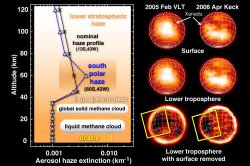Written by Fraser Cain

If you're planning a visit to Saturn's moon Titan, make sure you bring an umbrella. You'll need it. Not to protect you from water raining down; on frigid Titan, where temperatures dip below 180-degrees Celsius, all the water is completely frozen. No, according to scientists, there's a steady drizzle of liquid methane coming down in the mornings.
New infrared images gathered by Hawaii's W.M. Keck Observatory and Chile's Very Large Telescope show that Titan's Xanadu region experiences a steady drizzle of methane during its lengthy morning. The concept of morning is a little misleading, since Titan takes about 16 Earth days to complete one rotation. So, the "morning" drizzle actually lasts around 3 Earth days, dissipating around 10:30 a.m. local time.
Astronomers aren't actually sure if this is a moon-wide phenomenon, or just localized around the Xanadu region of Titan. Even though large lakes and seas have been discovered around the moon's poles, no process had been discovered that fills them with liquid… until now.
Reporting their findings in the latest issue of the online journal Science Express, researchers from UC Berkeley note that, "widespread and persistent drizzle may be the dominant mechanism for returning methane to the surface from the atmosphere and closing the methane cycle."
The new Keck/VLT images show a widespread cloud cover of frozen methane at a height of 25 to 35 kilometres. And then there are liquid methane clouds below 20 kilometres, and finally rain falling at the lowest elevations.
The droplets of liquid methane in the rain clouds are 1,000 times larger than water vapour here on Earth, and this surprisingly makes them harder to detect. Since the droplets are larger, but still carry the same amount of moisture, they're much more spread out, making the clouds extremely diffuse, and nearly invisible.
How much liquid is trapped in the clouds? If you squeezed them all out and spread the liquid across the surface of Titan, it would coat the entire moon to a depth of about 1.5 cm. And that's actually the same amount as we'd get if you did the same thing with the Earth's clouds.
Original Source: UC Berkeley News Release



No comments:
Post a Comment